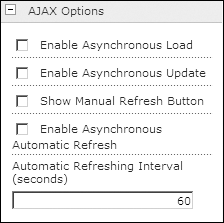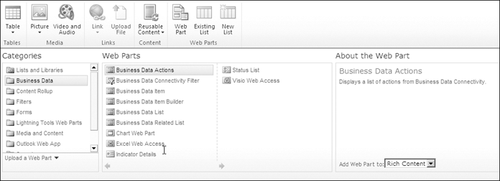The Web Parts available out
of the box with SharePoint 2010 have been organized into several
categories. You can enable and disable many of these categories or Web
Parts using features at the site collection level. For example, if you
enable the SharePoint Server Publishing Infrastructure, you will add a
total of six Web Parts to your site to support the publishing activities
such as the Content Query Web Part.
In this section, you’ll use
the Team Site template with publishing turned on as the basis for the
discussion of available Web Parts. Other templates will alter some of
your content, but not substantially. The categories in which Web Parts
are groups in the Team Site template are as follows.
It isn’t possible to cover
every Web Part in depth in the following sections, however. Some will be
mentioned briefly and a few will be discussed in depth.
1. Lists And Libraries Web Parts
The Web Parts that ship
with SharePoint in this category include those that have been available
since Microsoft SharePoint Portal Server 2003: Announcements, Shared
Documents, Tasks, Discussions, and Calendar.
One new Web Part that warrants note is the Drop
Off Library. This document library is provisioned to look at the
properties of a document as the document is uploaded into the library.
Then, based on the rules that the library owner configures for the
properties of the documents that are uploaded into the library, the
document is automatically moved to another library. You can think of
this library as a way to move documents to their proper hosting location
automatically, based on their metadata assignments.
|
SharePoint is full of
content stored in lists and libraries. The content includes list items,
documents, and images. The Content category provides you with Web Parts
that display content in different ways. There are rollup Web Parts that
aggregate content from lists or libraries in subsites along with Web
Parts that display the content of a specific list or library.
Every document
library and list Web Part within SharePoint can also be presented as a
Web Part on the page, using a Web Part known as a List View Web Part.
Some of the lists within a site would be useful if they were displayed
on the home page of the site as well as by navigating to the list by
using the Quick Launch. As an example, you could display the
Announcements list on the home page of a team site so that members of
that site see the announcements as soon as they navigate to the page.
SharePoint 2010 improves on the performance and user interface of the List
View Web Part. The performance has been improved by providing AJAX
options and therefore allowing the data to refresh automatically rather
than by page refresh. Cache options have also been improved for the Web
Part. Both of these options help improve page load times within your
SharePoint environment. The new AJAX options can be seen in the tool
pane when you edit a Web Part (see Figure 7).

The user interface of the List View Web Part, shown in Figure 19-8,
provides better toolbar options, which can be turned on or off in the
tool pane by turning the toolbar option on or off. It also displays the
document icon, alternate row colors, and an Add New Item link at the
bottom of the list items, which provides a quick way to add content.

Because site collections can
become large in terms of the amount of data they host, it is sometimes
helpful to roll up certain types of data into a single view. Don’t
expect site members to visit each site they belong to on a daily basis
to check for new assigned tasks, documents, or announcements. The Content
Rollup Web Part addresses this problem. It aggregates information (list
items) from lists on multiple sites of the site collection and adds
them to one Web Part. This one Web Part allows you to navigate to access
your content.
|
2. Business Data Web Parts
The Business Data Web Parts in
SharePoint 2010 are somewhat similar to what is available with
SharePoint Server 2007. The purpose of the Business Data Web Parts is to
present line-of-business data on Web Parts Pages. Each of the Web Parts
can be connected to other business data Web Parts to provide the
ability to drill down through data, such as to select a customer and
then see the order history for that customer. The Web Parts can be used
throughout SharePoint on Web Part Pages, team sites, dashboard sites,
and workspaces. They can provide flexibility for the information worker
to customize or personalize some aspects of the Web Part.
Figure 9
shows the Insert Web Part option, used to add a new Web Part on the
page, displaying the choice of Web Parts in the Business Data category.

2.1. Business Data Actions
The Business
Data Actions Web Part provides users with a list of actions that they
can perform on a row of data from an external content type.
Note:
What was called an Entity in
SharePoint Server 2007 is now called an external content type in
SharePoint 2010. It is effectively a dataset that contains an
enumerator, methods, filters, and actions that can be used on a result
set such as a table or stored procedure.
An action
can be almost any URL that accepts parameters. The actions provide
endless functionality to information workers who want to do more with
the business data than just present it in a list or library. For
example, think about what an end user needs to do with customer
information. If the end user is a sales representative, he might want to
search for customer information in an Internet search engine, look the
customer up in a customer relationship management (CRM) system, or even
send an e-mail to that customer.
The custom actions are
created at the time of authoring the external content type using Visual
Studio, SharePoint Designer, or a third-party tool. The following is an
example of what a custom action looks like.
http://www.bing.com?searchparameter={0}
The {0} is a placeholder
for one of the column values for a specific row. For example, if you
click the custom action on Sven Freitag, the action would be a URL that
looks like the following.
http://www.bing.com?searchparameter=Sven%20Freitag
The Business
Data Actions Web Part is not the only place where these actions can be
run; they can also be run from the title property in the Business Data
List Web Part.
2.2. Business Data Catalog Filter
This Web Part is very useful
within dashboard pages where your line-of-business data can involve data
stored within a back-end system such as an Oracle database, but you
also have related data stored in SharePoint lists and libraries. For
example, your customer information might come from the CRM application
by way of Business Connectivity Services (BCS), but your proposals for
each customer are stored within a SharePoint document library.
Therefore, to link this information together, you can configure the Business
Data Catalog Filter Web Part to provide you with a choice of rows
whereby you can select a customer. A Web Part connection can then be
sent to the List View Web Part to allow the filtering of documents.
Therefore, if you want to see all documents related to Sven Freitag, you
would select Sven Freitag from the Business Data Catalog Filter Web
Part.
2.3. Business Data Item
The Business
Data Item Web Part displays one row of data from an external content
type in a columnar format. This Web Part is used out of the box on the
profile page that is generated when the external content type is
created. The Business Data Item Web Part contributes to a well-laid-out
dashboard page. Quite often your tables will contain too many columns to
display all of them on the screen using the Business Data List Web
Part. For example, a table containing customer information could have
the following columns.
Customer ID
Company Name
Address
Address2
City
State
ZIP
Country
Telephone
Fax
Website
Displaying all of that
information in a horizontal table layout would take up too much room on
the page. Instead, you might decide to show only the company name,
city, and state columns. This would take up less room but still allow
you to drill down if required. In other words, you link the Business
Data List Web Part to the Business Data Item Web Part that shows all of
the columns. Because the Business Data Column Web Part is displayed in
columnar format, the width of the page doesn’t matter. To show detailed
information, you simply need to click the name of one of your customers.
Although the Business
Connectivity Services Web Parts still play a big role in BCS, the
external list is a preferred method of displaying line-of-business data
from an external content type because it also provides create, read,
update, and delete (CRUD) capabilities. The external list can also be
added to a SharePoint page just like a List View Web Part. They might
not look very impressive initially, but when they are added to a Web
Part Page, the additional columns, formatting, grouping, and so forth
can be set in SharePoint Designer 2010 just like with any List View Web
Part or Data View Web Part. An external list is shown in Figure 10.

2.4. Status Indicator
SharePoint Server 2007 saw the introduction of a Key Performance Indicator (KPI) Web Part that has now been replaced with the Status
Indicator Web Part. PerformancePoint Services in Microsoft SharePoint
2010 provides a far better KPI view than that of the previous KPI Web
Part.
Status indicators are
configured via a status list Web Part that can be created within any
site to show the status of SharePoint list values, a Microsoft Excel
workbook, Microsoft SQL Server Analysis Services, or Fixed Values. Goals
can be set for each cell or row, or the data can be entered manually,
depending on your source. The Status Indicator Web Part is then
configured to point at your status indicator list and then displays the
KPIs as required. The Status Indicator Web Part can also be connected to
the Status Indicator Details Web Part to allow a user to drill down to
see details. The Status Indicator Web Part is shown in Figure 11.
